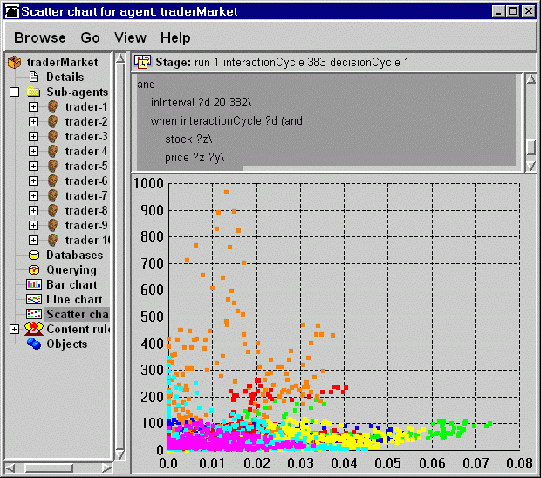| physics
vs. biology paradigm There
is a wish that if the right assumption can be made, the 'field work'
to make a model can be missed out. This desire for a 'quick fix'
leads to use of (unvalidated) prior assumptions. However, structured
uncertainty that means that assumptions cannot just be applied,
assuming that they will average out. This radical uncertainty, means
that such things as the Law of Large Numbers will not apply. Instead,
social simulation needs to copy aspects of biology:
-
Lots of field-work and description
- Post
hoc generalisation and approximation
- Almost
no generally applicable theory
The
aim then is to produce a descriptive model, which after it has been
developed, can be used to make assumptions.

bottom-up,
descriptive approach
This
approach aims not to take some pre-theory of cognition, but to develop
the model to capture reports of social mechanisms as directly as
possible. This will then be validated against the people involved,
the expert opinion of stakeholders, academics and the data, and
then adapted again as necessary. The idea is to present these interested
parties with a context for provoking a response. Then, patterns
will be looked for, and generalisations made to summarise emergent
processes. These will then be used in a coarser grained model, and
then this process will be repeated
SDML's
support for social simulation
This
support is computational, not numeric. The syntax used for facts
is very flexible, and includes names numbers, matrices and symbols,
and is kept in databases throughout the model. The rules then act
upon these databases of facts to produce a set of facts consistent
with rules. The aim is the manipulation of tokens, from the point
of view of the stakeholders; this is not just a social experiment.
This means that the process of interpretation is as natural and
straightforward as possible, and that is easier to model qualitative
processes.
declarative
approach
The
approach taken means that control is separated from the data, and
that the flexibility of knowledge representation is maximised. This
means that changes required in response to comments made by the
stakeholders can more easily be made. Furthermore, this means that
relations are specified, and that processes emerge to be examined,
rather than that processes are specified and relations and state
emerge.
 agent
and temporal features agent
and temporal features
Agents
and objects naturally occur in description of stakeholders (and
others). This means that they can more easily be adapted into the
model. There is included local time/variable temporal granularity
to suit situations, and non instantaneous communication forces appropriate
model development. There are composite agents for institutions,
collections etc.
result
modelling (1)
- The
complexity of the model that may result from this is surely inevitable
in light of the complex subject area. As it is therefore difficult
to understand the results of the model, so it is necessary to
model the results of the model. A complete browsable simulation
record means you do not have to guess what data you will need
to record before hand, and pseudo-linguistic output means that
non-experts can easily relate to the results.
result
modelling (2)
- The
results are queryable (including to simple graphs), which facilitates
the understanding of complex models.

result
modelling (3): flexibility (1)
The
large vocabulary of built-in predicates means that new predicates
are easy to develop and incorporate. The multiple inheritance
type hierarchy and modules, and declarative basis means that there
has a sharp learning curve, but this is then followed by rapid
model development and adaptation. This means that it can used
responsively, supporting iterative and stakeholder led development,
and responding to user demand.

result
modelling (3): flexibility (2)
The
fact that the model has within it hooks for integration to other
systems/models and runs on many platforms means that developing
and aligning models at different grains and aspects are facilitated
(compositional methodology).
 exploration
of possibilities exploration
of possibilities
One
of the advantages of this system is that the model can be used to
explore possibilities. There is controlled arbitrariness, and constraint-based
features for exploration of complete space. This allows known uncertainties
to be explicitly represented and tagged, and means that the uncertainty
of outcomes in the model can be rigorously explored and determined
SDML's
role in FIRMA
Other advantages of this system are the fast and flexible exploration
and development of modelling techniques it permits. Models of different
types can be integrated, and at different granularities/levels.
SDML can be a way of facilitating dialogue between academics and
stakeholders |



